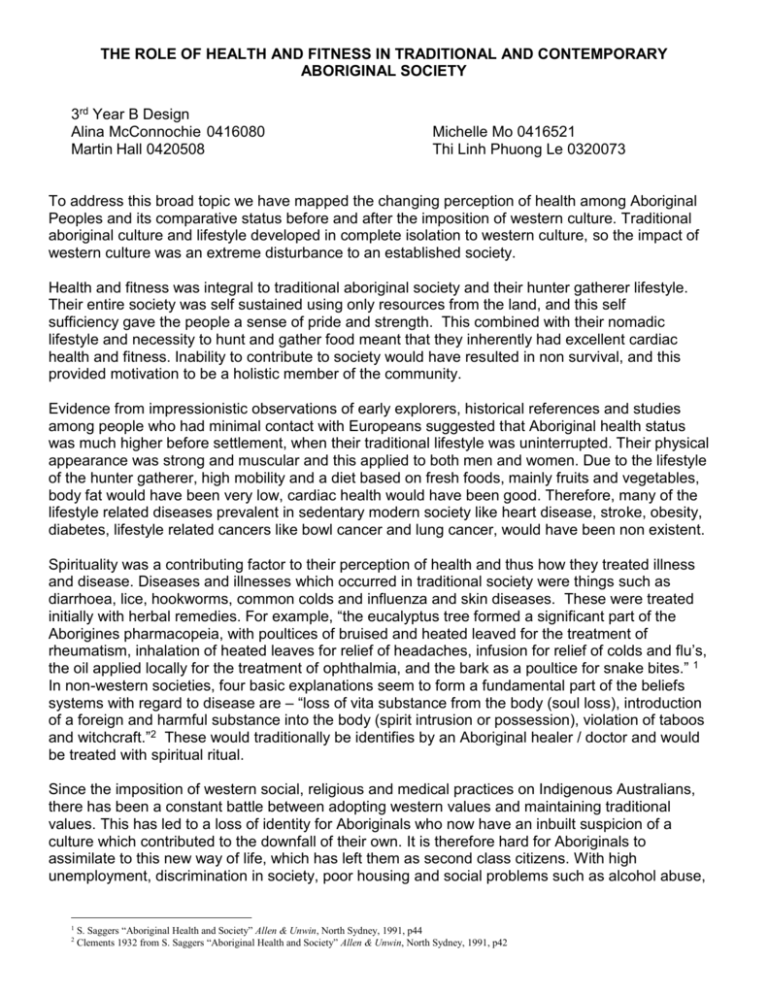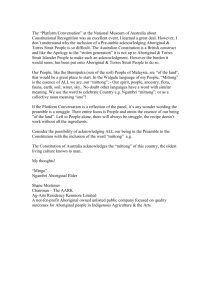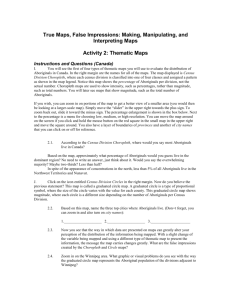The role of health and fitness in traditional and contemporary
advertisement

THE ROLE OF HEALTH AND FITNESS IN TRADITIONAL AND CONTEMPORARY ABORIGINAL SOCIETY 3rd Year B Design Alina McConnochie 0416080 Martin Hall 0420508 Michelle Mo 0416521 Thi Linh Phuong Le 0320073 To address this broad topic we have mapped the changing perception of health among Aboriginal Peoples and its comparative status before and after the imposition of western culture. Traditional aboriginal culture and lifestyle developed in complete isolation to western culture, so the impact of western culture was an extreme disturbance to an established society. Health and fitness was integral to traditional aboriginal society and their hunter gatherer lifestyle. Their entire society was self sustained using only resources from the land, and this self sufficiency gave the people a sense of pride and strength. This combined with their nomadic lifestyle and necessity to hunt and gather food meant that they inherently had excellent cardiac health and fitness. Inability to contribute to society would have resulted in non survival, and this provided motivation to be a holistic member of the community. Evidence from impressionistic observations of early explorers, historical references and studies among people who had minimal contact with Europeans suggested that Aboriginal health status was much higher before settlement, when their traditional lifestyle was uninterrupted. Their physical appearance was strong and muscular and this applied to both men and women. Due to the lifestyle of the hunter gatherer, high mobility and a diet based on fresh foods, mainly fruits and vegetables, body fat would have been very low, cardiac health would have been good. Therefore, many of the lifestyle related diseases prevalent in sedentary modern society like heart disease, stroke, obesity, diabetes, lifestyle related cancers like bowl cancer and lung cancer, would have been non existent. Spirituality was a contributing factor to their perception of health and thus how they treated illness and disease. Diseases and illnesses which occurred in traditional society were things such as diarrhoea, lice, hookworms, common colds and influenza and skin diseases. These were treated initially with herbal remedies. For example, “the eucalyptus tree formed a significant part of the Aborigines pharmacopeia, with poultices of bruised and heated leaved for the treatment of rheumatism, inhalation of heated leaves for relief of headaches, infusion for relief of colds and flu’s, the oil applied locally for the treatment of ophthalmia, and the bark as a poultice for snake bites.” 1 In non-western societies, four basic explanations seem to form a fundamental part of the beliefs systems with regard to disease are – “loss of vita substance from the body (soul loss), introduction of a foreign and harmful substance into the body (spirit intrusion or possession), violation of taboos and witchcraft.”2 These would traditionally be identifies by an Aboriginal healer / doctor and would be treated with spiritual ritual. Since the imposition of western social, religious and medical practices on Indigenous Australians, there has been a constant battle between adopting western values and maintaining traditional values. This has led to a loss of identity for Aboriginals who now have an inbuilt suspicion of a culture which contributed to the downfall of their own. It is therefore hard for Aboriginals to assimilate to this new way of life, which has left them as second class citizens. With high unemployment, discrimination in society, poor housing and social problems such as alcohol abuse, 1 2 S. Saggers “Aboriginal Health and Society” Allen & Unwin, North Sydney, 1991, p44 Clements 1932 from S. Saggers “Aboriginal Health and Society” Allen & Unwin, North Sydney, 1991, p42 all resulting from this distinct change in lifestyle, it is easy to see why health and fitness are also considerably behind that of the rest of the nation. Circulatory and respiratory illnesses have a much higher incidence in Indigenous Australians, as does diabetes with contributing factors such as low socio-economic status, poor education, smoking, poor nutrition leading to obesity, alcohol and lack of exercise. Previous beliefs that Aboriginals have a genetic pre-disposition to diabetes are completely ungrounded. Differences in the delivery of healthcare also pose problems resulting in Aboriginals being unlikely to accept treatment from medical staff of the opposite sex. Due to language barriers they are also likely to leave healthcare facilities before treatment is completed. Poor mental health also has a high incidence in Aboriginals because of the exclusion of their culture, beliefs and way of life from contemporary Australian society, which results in a loss of identity and place. Struggles exist with the direct results of drug and alcohol abuse, and their indirect effects on family and the community. Exclusion from the countries main opportunity structures because the delivery of western education is culturally inappropriate and therefore poorly received by aboriginal people. As a result of all these factors the perception of health and fitness in the Aboriginal community at present is that their health status is predetermined. Especially in young people, who observe their immediate family and sections of the community, a high proportion of which are involved in drugs, alcohol, violence and poor nutritional practices. Fitness is another area, like healthcare, that requires a different approach than that of western culture. Where western ideas of fitness revolve around strict rule based games, regularity and repetition, Aboriginals are not into this type of structure. From an interview with the coordinator of The Settlement we received specific insight into what fitness activities younger people within the Redfern community enjoy and respond to. Community groups such as The Settlement do not only provide a sense of place and belonging, they put an emphasis on fitness in a delivery method that is suitable for Aboriginals. Within this informal environment, leaders are able to educate youths about drugs, alcohol, crime and other prominent issues, in a non-threatening setting. The Settlement also runs sports programs, where kids can gain skill and a sense of achievement. Games which focus on teamwork and involve balls are often successful, a they do not necessarily relate these activities to fitness, rather participate because of the enjoyment they provide. Large outdoor areas are also likely to encourage fitness related activities, as they are not restricted to specific activities or games. Aboriginal sporting role models are also held in high regard, giving youths something to aspire to. These role models not only express sporting prowess, but their dedication, strength and belief empower the Aboriginal community to raise certain expectations. Institutions such as this one provide a sense of community and ownership to the Aboriginals of Redfern, giving them the belief they need to lift crucial issues such as socio-economic status, housing, family life, unemployment, drug and alcohol issues and social acceptance. The new development of the Community Centre and the proposals for community and housing buildings on The Block, provide an example of how Aboriginal communities are improving with resources and facilities that give a sense of ownership back to the community so that they can practice their culture, lifestyle and traditional medicine. Hopefully, allowing them this control will enable them to practice a healthier and more active lifestyle, while increasing their overall standing in the wider community.









